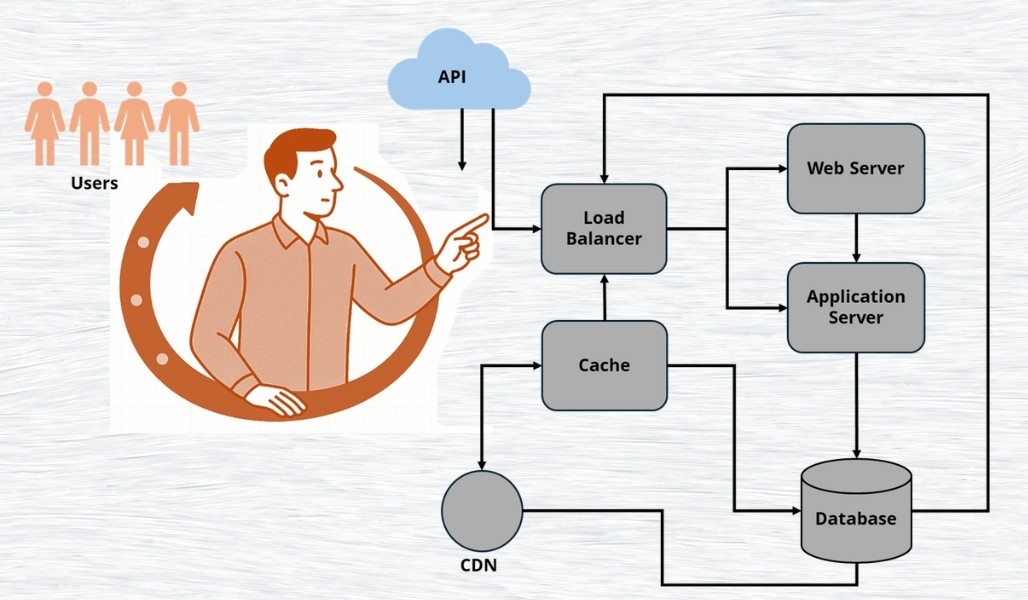By: Anisha Sagi
Creating software systems that can grow is like planning a city – you need solid foundations, intelligent resource management, and room to expand. Good system design distinguishes thriving and failing under pressure, creating a small service or the next big social platform. Before diving into code, you need to clarify what you’re building. What features do users need? How many people will use it? How fast should it respond? These requirements shape every decision that follows. Skipping this groundwork often leads to painful rebuilds later.
Enterprise API Management Solution

Think of system architecture like building blocks. You typically have frontend interfaces that users interact with, an API gateway controlling traffic, application servers handling business logic, databases storing information, and supporting services like caches and message queues. Start simple, then expand as needed. When your system needs to grow, you have two main options: vertical scaling (adding more power to existing machines) and horizontal scaling (adding more machines to share the load). Horizontal scaling usually wins for bigger systems because it’s more flexible and fault-tolerant. Load balancers become crucial here – they’re like traffic cops directing requests across servers to prevent bottlenecks.
Caching is another performance game-changer. You dramatically cut load times by keeping frequently accessed data in fast memory. You can cache at different levels: in the browser, at network edges using CDNs, and in your application using tools like Redis. The right caching strategy can make your system feel lightning-fast to users while reducing server load. As Redis’s best practices outlined, careful cache design is essential for maintaining consistency while maximizing agility.
Choosing the proper database is crucial. SQL databases like Oracle excel at handling structured, related data (think banking transactions). NoSQL databases like MongoDB shine with flexible, less structured data (think social media posts). MongoDB’s documentation demonstrates how techniques like sharding and replication help databases scale reliably. Services need to talk to each other effectively through synchronous (REST/HTTP), suitable for immediate responses, or asynchronous (message queues), better for handling high loads. Think of synchronous communication like a phone call – you wait for responses. Asynchronous is more like email – services can work independently. Apache Kafka, a popular messaging system, is excellent for handling high-volume event streams.
Several specific design patterns have proven invaluable in building scalable systems. The Microservices architecture pattern, for instance, has gained significant traction in recent years. This approach involves breaking down a monolithic application into smaller, independently deployable services. This flexibility allows companies to scale and update different parts of their system independently, handling significant increases in traffic while maintaining high availability.
Another crucial pattern is the Circuit Breaker. To ensure the system does not experience a failure in distributed systems, this pattern temporarily turns off a failing service to allow it time to recover. Implementing this pattern can significantly improve a system’s resilience during traffic spikes or when dealing with slow downstream dependencies.
Event Sourcing is another powerful pattern that logs all changes as a sequence of events to enable historical audit. This approach provides a complete audit trail, enables easy rollbacks, and facilitates complex event-driven architectures. It’s handy in financial systems and applications requiring strong consistency and traceability.
Building reliable systems means planning for failure. To prevent cascade failures, include redundant components, health monitoring, smart retry logic, and circuit breakers. Security can’t be an afterthought. Encrypt sensitive data, validate inputs, control access, and secure communication channels. Make systems maintainable through clean, modular code, clear documentation, automated testing, and streamlined deployment.
When tackling design problems, start by listing requirements and constraints, sketching the high-level architecture, detailing key components, planning for scaling and failure cases, and iterating based on feedback. Practice by designing standard systems like URL shorteners (handling unique IDs and redirects), chat apps (managing real-time messages), and social feeds (balancing pace and consistency).
Performance optimization is crucial in system design. Database indexing, query optimization, and efficient data structures can significantly improve response times. For example, using appropriate indexes can turn a query that scans millions of rows into one that quickly retrieves the exact data needed. Profiling tools help identify bottlenecks, allowing you to focus optimization efforts where they’ll have the most impact.
Scalability challenges often arise as systems grow. Common issues include database bottlenecks, increased latency, and resource contention. Solutions involve implementing read replicas to offload queries, sharding to distribute data across multiple servers, or caching layers to reduce database load. It’s crucial to design with scalability in mind, anticipating potential growth points and planning for them.
Security considerations should be woven throughout the design process. By this, I mean authentication and authorization mechanisms, encrypting data in transit and at rest, and regularly auditing and updating security measures. A defense-in-depth approach can be implemented to help with potential threats.
Remember: Good system design isn’t about using every trendy technology. It’s about choosing the right tools to build reliable, scalable solutions that solve real problems. This framework will better equip you to design systems that address the challenges of modern software engineering.
Published by Joseph T.


















